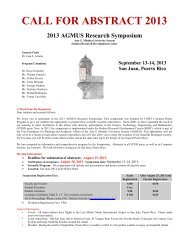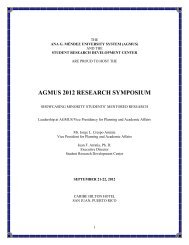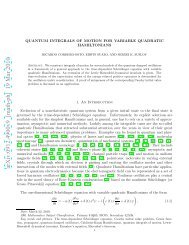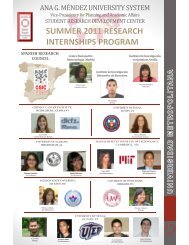WINTER 2008 PRE-COLLEGE RESEARCH SYMPOSIUM - Student ...
WINTER 2008 PRE-COLLEGE RESEARCH SYMPOSIUM - Student ...
WINTER 2008 PRE-COLLEGE RESEARCH SYMPOSIUM - Student ...
Create successful ePaper yourself
Turn your PDF publications into a flip-book with our unique Google optimized e-Paper software.
STUDY OF MUTATIONS IN MUT: LEAD CAUSE OF METHYLMALONIC ACIDEMIA<br />
Tatiana Rosado, Bautista de Levittown School, Toa Baja, Puerto Rico.<br />
Research Mentors: Dr. Juan F. Arratia, Executive Director, <strong>Student</strong> Research Development<br />
Center, Ana G. Méndez University System, San Juan, Puerto Rico; Dr. Sudhir Kumar,<br />
Department of Biology, Arizona State University, Tempe, Arizona.<br />
<strong>Student</strong> Research Mentor: Krizia Cabrera, Universidad Metropolitana, San Juan, Puerto Rico.<br />
Methylmalonic acidemia is an inherited disorder in which the body is unable to process certain<br />
proteins and fats properly. Mutations in the MUT (methylmalonyl Coenzyme A mutase) gene and<br />
other genes are the cause for methylmalonic acidemia. The MUT gene provides instructions for<br />
making an enzyme called methylmalonyl CoA mutase that works with vitamin B12 to break<br />
down several amino acids, certain lipids, and cholesterol. Mutations alter the enzyme's structure<br />
or reduces the amount of the enzyme, which prevents these molecules from being broken down<br />
properly. As a result, a substance called methylmalonyl CoA and other potentially toxic<br />
compounds can accumulate in the body's organs and tissues, causing the signs and symptoms of<br />
methylmalonic acidemia. SIFT, Sorting Intolerant from Tolerant, is a program that is used to<br />
anticipate how a certain substitution can affect a protein function. It calculates the effect of a<br />
substitution by comparing the conserved sites with the mutation. Conserved sites are amino acids<br />
that tend to stay the same throughout time. Another program was used to compare the human<br />
protein to homolog species to evaluate any change that may have occurred during time. The<br />
program used was MEGA 4 (Molecular Evolutionary Genetics Analysis 4). The homolog species<br />
were G. gallus, R. norvegicus, B. Taurus, O. cuniculus, and D. rerio. After evaluating the amino<br />
acid substitution, only 2% of the mutations were tolerant. This may suggest two things: the<br />
protein may be much conserved or the mutations analyzed have amino acids that may be essential<br />
to the protein function or structure.<br />
24








